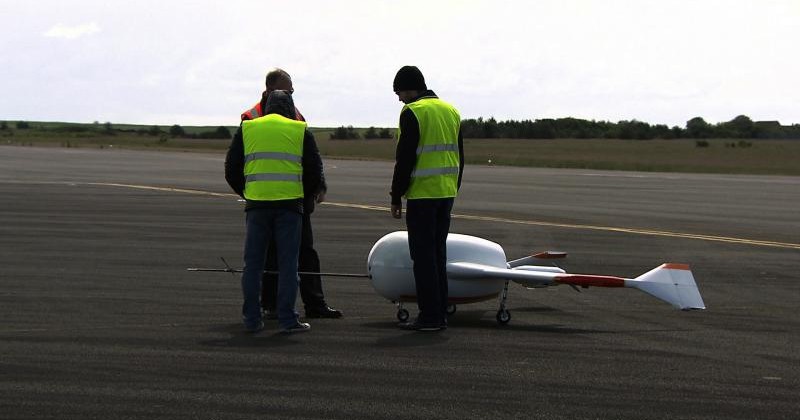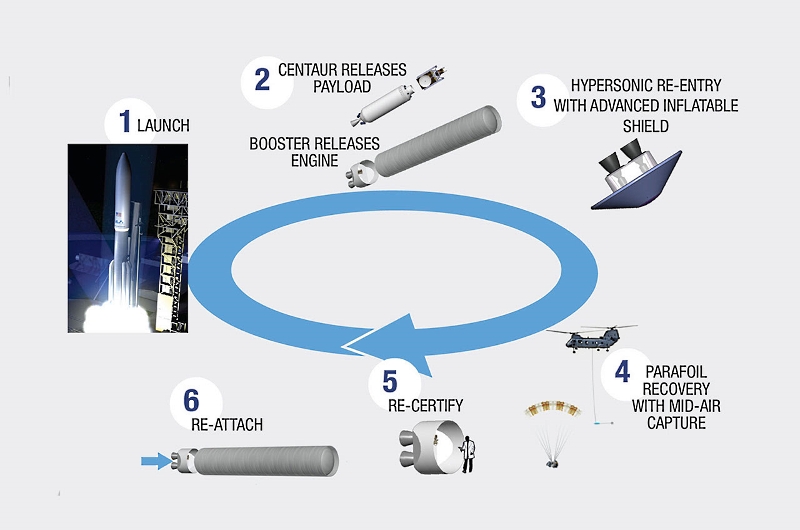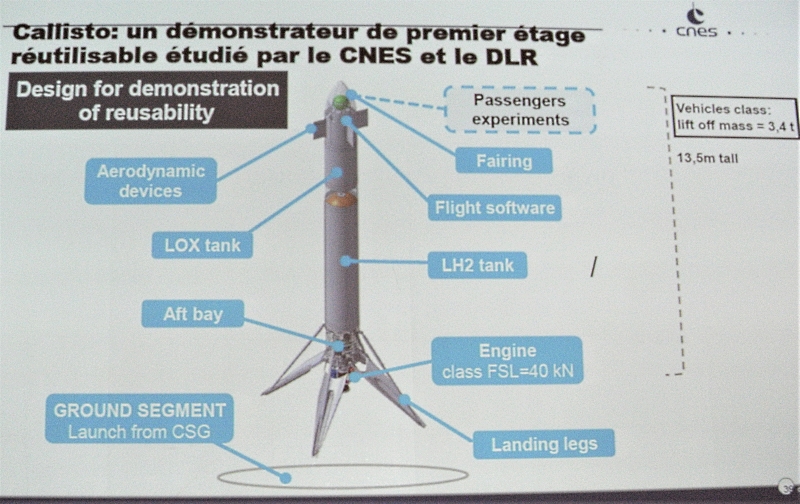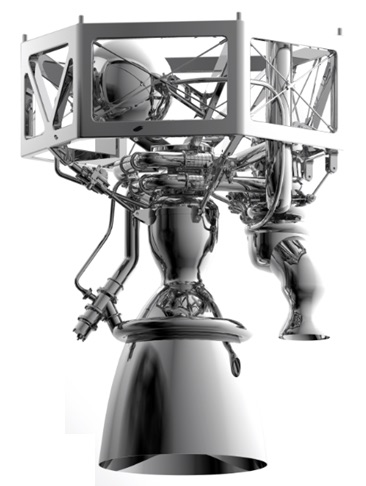Not a single Falcon - fundamentally different reusable projects by ESA and ULA
The flights of SpaceX's reusable first stages of the Falcon rocket boosted a surge of interest in reusable rockets. And if, for example, the Chinese company LinkSpace demonstrates renders of a similar system with landing on engines on folding supports, other designers offer systems on different principles, using wings or air pickup. Some projects have already managed to close, but there are freshly announced ones.

Technological demonstrator Adeline
In 2015, there were news that Airbus Defense and Space are developing a reusable Adeline module, which is a winged unit with a first-stage rocket engine, as well as air engines and propellers for landing on the runway. The concept is most clearly illustrated by a video that is no longer available on the official channel, but saved by ordinary users.
The idea to save only the tail of the rocket has its advantages - the engines, avionics and equipment of the tail section make up, according to Adeline developers, 80% of the cost of the stage, and saving them is much easier than the larger stage entirely. Fuel is also saved, and there are no overloads experienced by the step when landing on engines. But, of course, everything has a price - the gain in fuel economy will be partially eaten up by losses on the additional mass from the wings.
')
The tail part of Adeline was proposed for use in Ariane 6, although, theoretically, it could be modified for other media. When the project was officially announced, it turned out that work has been going on since 2010, and successful tests of large-scale models have already been carried out. After the loud announcement of the abundance of news on the project was not - the priority of Airbus Defense and Space is the new Ariane 6 launch vehicle. And in 2018 information appeared that the project did not arouse interest for financial reasons.
The German Center for Aviation and Astronautics, part of the ESA, on March 20 this year announced the start of work on the concept of a cruise missile stage, which will be caught and towed by an aircraft carrier. The project was named FALCon (Formation flight for in-flight Launcher 1st stage Capturing demonstration, “Flight in the ranks to demonstrate pickup of the first stage of the carrier”), with the exception of the letter case that matches the name of the Falcon SpaceX launch vehicle. Due to the coincidence of the names, the project manager Martin Sippel had to explain that the engineers were inspired by the falcon diving to grab the victim, and not the SpaceX rocket.

FALCon operation diagram, DLR illustration
Landing rocket stages on the engines has a serious drawback - it is necessary to separate the stage, when it still has a lot of fuel, which is then spent on landing. Worse, because of the Oberth effect, it is this fuel that is most valuable for accelerating the payload. In the case of FALCon, the planning descent will allow spending all the fuel from the tanks - before landing, the stage will be pulled by a towing plane. But, of course, this gain, like that of Adeline, will be eaten by the increased weight of the stage due to the added wings.
An important element of the system will be the design for picking up and towing the stage. Engineers mention the design of a guided docking / towing cone.

Managed docking / towing cone
The usual cones of the refueling aircraft are uncontrollable - the pilots of the filled aircraft themselves catch them, maneuvering their vehicles. This is not a quick and difficult task, so for a stage planning with the engines off, the controlled cone should make the task noticeably easier. But apart from this, improvements for the towing aircraft are almost not required, and as such it will be possible to use ordinary passenger planes, moreover, second-hand for greater savings.
The work on FALCon is at the very beginning, and, as in the case of Adeline, the tests will first be carried out with unmanned aerial vehicles, not missiles. 2.6 million euros have been allocated to the project so far, which is not much, but it will be enough for the first experiments. The project has a long enough time frame - the airworthiness of the system should reach around 2028 to possibly be used in the new generation stage, which may appear around 2035.
The Falcon 9 landing stage performs as many as three engine starts - boostback burn, in which the stage takes aim at the landing area, the entry burn stops the stage so that it does not overheat, and the final landing switch. All three use precious fuel, and, despite the fact that parachutes cannot provide an accurate fit, they would weigh less than the fuel needed for these maneuvers. The idea to use parachutes and helicopter pickup is going to be implemented by the ULA launch services provider in its developed Vulcan launch vehicle. The tail section of the first stage should be discharged, open a supersonic parachute for braking in dense layers of the atmosphere, reset it, open a guided parachute-wing, be picked up by helicopter, delivered to the ground, tested and reused.

ULA Scheme
In the video:
The latest news on the project dates back to the beginning of August 2018, when ULA received $ 1.9 million from NASA to demonstrate the technology of aerial pickup of an object returning from orbit.
The French National Center for Space Research (CNES) is also engaged in experiments with reusability. “Callisto” is a technological demonstrator of a suborbital reusable stage with a rocket landing, comparable to SpaceX's Grasshopper, but featuring an oxygen-hydrogen engine.

CNES presentation frame
In the future, a full-fledged launch vehicle may grow from this, but not soon - the priority of CNES is to first reduce the cost of the launch vehicles being developed, and then the return stages. The approach is very robust, I remind you that Mask first proposed a competitive one-time Falcon 9, began to receive orders, and only then began to turn it into a reusable rocket.
Another direction of CNES is the Prometheus methane engine. Using new technologies, including 3D printing, they are going to make it 10 times cheaper than the Ariane 5 central unit (second stage) engine. If everything goes well, the engine will be used in the new Ariane 6 modification or the next ESA rocket.

Prometheus engine, CNES image
Experiments with different reusable rockets can only be welcomed by the phrase of the Chinese emperor Qin Shi Huang (which was then reused by Mao Zedong): "Let a hundred flowers bloom, let a hundred schools compete." Each technical solution has its pros and cons, and let the practice show which option will be better.

Technological demonstrator Adeline
Adeline is no more
In 2015, there were news that Airbus Defense and Space are developing a reusable Adeline module, which is a winged unit with a first-stage rocket engine, as well as air engines and propellers for landing on the runway. The concept is most clearly illustrated by a video that is no longer available on the official channel, but saved by ordinary users.
The idea to save only the tail of the rocket has its advantages - the engines, avionics and equipment of the tail section make up, according to Adeline developers, 80% of the cost of the stage, and saving them is much easier than the larger stage entirely. Fuel is also saved, and there are no overloads experienced by the step when landing on engines. But, of course, everything has a price - the gain in fuel economy will be partially eaten up by losses on the additional mass from the wings.
')
The tail part of Adeline was proposed for use in Ariane 6, although, theoretically, it could be modified for other media. When the project was officially announced, it turned out that work has been going on since 2010, and successful tests of large-scale models have already been carried out. After the loud announcement of the abundance of news on the project was not - the priority of Airbus Defense and Space is the new Ariane 6 launch vehicle. And in 2018 information appeared that the project did not arouse interest for financial reasons.
FALCon, but not Falcon
The German Center for Aviation and Astronautics, part of the ESA, on March 20 this year announced the start of work on the concept of a cruise missile stage, which will be caught and towed by an aircraft carrier. The project was named FALCon (Formation flight for in-flight Launcher 1st stage Capturing demonstration, “Flight in the ranks to demonstrate pickup of the first stage of the carrier”), with the exception of the letter case that matches the name of the Falcon SpaceX launch vehicle. Due to the coincidence of the names, the project manager Martin Sippel had to explain that the engineers were inspired by the falcon diving to grab the victim, and not the SpaceX rocket.

FALCon operation diagram, DLR illustration
Landing rocket stages on the engines has a serious drawback - it is necessary to separate the stage, when it still has a lot of fuel, which is then spent on landing. Worse, because of the Oberth effect, it is this fuel that is most valuable for accelerating the payload. In the case of FALCon, the planning descent will allow spending all the fuel from the tanks - before landing, the stage will be pulled by a towing plane. But, of course, this gain, like that of Adeline, will be eaten by the increased weight of the stage due to the added wings.
An important element of the system will be the design for picking up and towing the stage. Engineers mention the design of a guided docking / towing cone.

Managed docking / towing cone
The usual cones of the refueling aircraft are uncontrollable - the pilots of the filled aircraft themselves catch them, maneuvering their vehicles. This is not a quick and difficult task, so for a stage planning with the engines off, the controlled cone should make the task noticeably easier. But apart from this, improvements for the towing aircraft are almost not required, and as such it will be possible to use ordinary passenger planes, moreover, second-hand for greater savings.
The work on FALCon is at the very beginning, and, as in the case of Adeline, the tests will first be carried out with unmanned aerial vehicles, not missiles. 2.6 million euros have been allocated to the project so far, which is not much, but it will be enough for the first experiments. The project has a long enough time frame - the airworthiness of the system should reach around 2028 to possibly be used in the new generation stage, which may appear around 2035.
Different parachutes from ULA
The Falcon 9 landing stage performs as many as three engine starts - boostback burn, in which the stage takes aim at the landing area, the entry burn stops the stage so that it does not overheat, and the final landing switch. All three use precious fuel, and, despite the fact that parachutes cannot provide an accurate fit, they would weigh less than the fuel needed for these maneuvers. The idea to use parachutes and helicopter pickup is going to be implemented by the ULA launch services provider in its developed Vulcan launch vehicle. The tail section of the first stage should be discharged, open a supersonic parachute for braking in dense layers of the atmosphere, reset it, open a guided parachute-wing, be picked up by helicopter, delivered to the ground, tested and reused.

ULA Scheme
In the video:
The latest news on the project dates back to the beginning of August 2018, when ULA received $ 1.9 million from NASA to demonstrate the technology of aerial pickup of an object returning from orbit.
Prometheus and Callisto
The French National Center for Space Research (CNES) is also engaged in experiments with reusability. “Callisto” is a technological demonstrator of a suborbital reusable stage with a rocket landing, comparable to SpaceX's Grasshopper, but featuring an oxygen-hydrogen engine.

CNES presentation frame
In the future, a full-fledged launch vehicle may grow from this, but not soon - the priority of CNES is to first reduce the cost of the launch vehicles being developed, and then the return stages. The approach is very robust, I remind you that Mask first proposed a competitive one-time Falcon 9, began to receive orders, and only then began to turn it into a reusable rocket.
Another direction of CNES is the Prometheus methane engine. Using new technologies, including 3D printing, they are going to make it 10 times cheaper than the Ariane 5 central unit (second stage) engine. If everything goes well, the engine will be used in the new Ariane 6 modification or the next ESA rocket.

Prometheus engine, CNES image
Conclusion
Experiments with different reusable rockets can only be welcomed by the phrase of the Chinese emperor Qin Shi Huang (which was then reused by Mao Zedong): "Let a hundred flowers bloom, let a hundred schools compete." Each technical solution has its pros and cons, and let the practice show which option will be better.
Source: https://habr.com/ru/post/445108/
All Articles